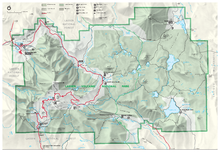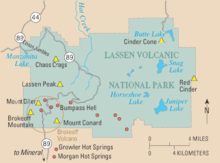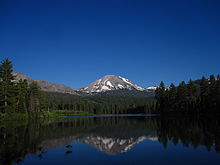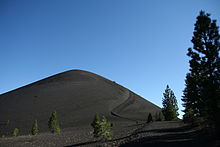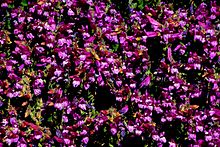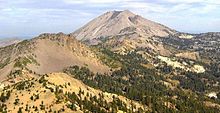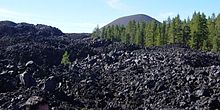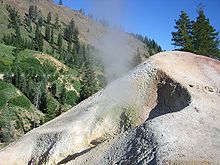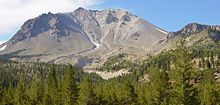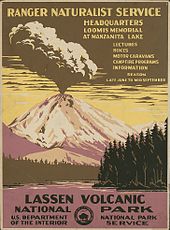- Lassen Volcanic National Park
-
Lassen Volcanic National Park IUCN Category II (National Park)Location Shasta, Lassen, Plumas, and Tehama Counties, California, USA Nearest city Redding and Susanville Coordinates 40°29′16″N 121°30′18″W / 40.4876594°N 121.5049807°WCoordinates: 40°29′16″N 121°30′18″W / 40.4876594°N 121.5049807°W Area 106,452 acres (43,080 ha)[1] Established August 9, 1916 Visitors 382,274 (in 2010)[2] Governing body National Park Service 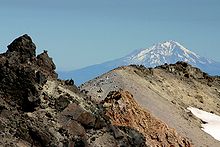 Mount Shasta from Lassen Peak
Mount Shasta from Lassen Peak
Lassen Volcanic National Park is a United States National Park in northeastern California. The dominant feature of the park is Lassen Peak; the largest plug dome volcano in the world and the southern-most volcano in the Cascade Range. Lassen Volcanic National Park started as two separate national monuments designated by President Theodore Roosevelt in 1907: Cinder Cone National Monument and Lassen Peak National Monument.
The source of heat for volcanism in the Lassen area is subduction off the Northern California coast of the Gorda Plate diving below the North American Plate. The area surrounding Lassen Peak is still active with boiling mud pots, stinking fumaroles, and churning hot springs. Lassen Volcanic National Park is one of the few areas in the world where all four types of volcano can be found (plug dome, shield, cinder cone, and strato).
The park is accessible via State Routes SR 89 and SR 44. SR 89 passes north-south through the park, beginning at SR 36 to the south and ending at SR 44 to the north. SR 89 passes immediately adjacent the base of Lassen Peak.
There are a total of five vehicle entrances to the park: the north and south entrances of SR 89, and unpaved roads entering at Drakesbad and Juniper Lake in the south, and Butte Lake in the northeast. The Park can also be accessed by trails leading in from Caribou Wilderness to the east, as well as the Pacific Crest Trail, and two smaller trails leading in from Willow Lake and Little Willow Lake to the south.
A large lodge (the Lassen Chalet) with concession facilities formerly was located near the south-west entrance, but was demolished in 2005. A new, full-service visitor center was constructed in the same location, and opened to the public in 2008. Near the old lodge location was also located Lassen Ski Area, which ceased operation in 1992; all infrastructure has been removed.
Contents
History
Native Americans have inhabited the area since long before white settlers first saw Lassen. The natives knew that the peak was full of fire and water and thought that it would one day blow itself apart.[3]
White immigrants in the mid-19th century used Lassen Peak as a landmark on their trek to the fertile Sacramento Valley. One of the guides to these immigrants was a Danish blacksmith named Peter Lassen, who settled in Northern California in the 1830s. Lassen Peak was named after him.[3] Nobles Emigrant Trail was later cut through the park area and passed Cinder Cone and the Fantastic Lava Beds.
Inconsistent newspaper accounts reported by witnesses from 1850-1851 described seeing "fire thrown to a terrible height" and "burning lava running down the sides" in the area of Cinder Cone. As late as 1859 a witness reported seeing fire in the sky from a distance, attributing it to an eruption. Early geologists and volcanologists who studied the Cinder Cone concluded the last eruption occurred between 1675 and 1700. After the 1980 eruption of Mount St. Helens, the United States Geological Survey (USGS) began reassessing the potential risk of other active volcanic areas in the Cascade Range. Further study of Cinder Cone estimated the last eruption occurred between 1630 and 1670.
The Lassen area was first protected by being designated as the Lassen Peak Forest Preserve. Lassen Peak and Cinder Cone were later declared as U.S. National Monuments in May 1907 by President Theodore Roosevelt.[4]
Brokeoff Mountain, Lassen Peak, and Chaos Crags, from left to right. The area of Lassen Peak that was lost during the 1914-15 volcanic event is visible in this picture, encompassing the sliver of snow.
Starting in May 1914 and lasting until 1921, a series of minor to major eruptions occurred on Lassen. These events created a new crater, and released lava and a great deal of ash. Fortunately, because of warnings, no one was killed, but several houses along area creeks were destroyed. Because of the eruptive activity, which continued through 1917, and the area's stark volcanic beauty, Lassen Peak, Cinder Cone and the area surrounding were declared a National Park on August 9, 1916.[3]
The 29-mile (47 km) Main Park Road was constructed between 1925 and 1931, just 10 years after Lassen Peak erupted. Near Lassen Peak the road reaches 8,512 feet (2,594 m), making it the highest road in the Cascade Mountains. It is not unusual for 40 ft (12 m) of snow to accumulate on the road near Lake Helen and for patches of snow to last into July.
In October 1972, a portion of the park was designated as Lassen Volcanic Wilderness by the US Congress (Public Law 92-511). The National Park Service seeks to manage the wilderness in keeping with the Wilderness Act of 1964, with minimal developed facilities, signage, and trails. The management plan of 2003 adds that, "The wilderness experience offers a moderate to high degree of challenge and adventure." [5]
In 1974 the National Park Service took the advice of the USGS and closed the visitor center and accommodations at Manzanita Lake. The Survey stated that these buildings would be in the way of a rockslide from Chaos Crags if an earthquake or eruption occurred in the area.[3] An aging seismograph station remains. However, a campground, store, and museum dedicated to Benjamin F. Loomis stands near Manzanita Lake, welcoming visitors who enter the park from the northwest entrance.
After the Mount St. Helens eruption, the USGS intensified its monitoring of active and potentially active volcanoes in the Cascade Range. Monitoring of the Lassen area includes periodic measurements of ground deformation and volcanic-gas emissions and continuous transmission of data from a local network of nine seismometers to USGS offices in Menlo Park, California.[6] Should indications of a significant increase in volcanic activity be detected, the USGS will immediately deploy scientists and specially designed portable monitoring instruments to evaluate the threat. In addition, the National Park Service (NPS) has developed an emergency response plan that would be activated to protect the public in the event of an impending eruption.
Visitors To Lassen National Park by Year [7] Year Recreational Visitors 2008 377,361 2007 395,057 2006 388,741 2005 365,535 2004 379,667 This table shows that visitors to Lassen increased in 2007 but have since fallen off below 2004 levels in 2008. The National Park Service counts visitors to Lassen National Park by using in-road inductive loops at all the vehicle entrances to count vehicles entering the park. Buses and other non-reportable vehicles are subtracted from the vehicle counts and then a persons-per-vehicle multiplier of 3 is multiplied by the vehicle number.[8]
Geography and climate
The park is located near the northern end of the Sacramento Valley. The western part of the park features great lava pinnacles (huge mountains created by lava flows), jagged craters, and steaming sulphur vents. It is cut by glaciated canyons and is dotted and threaded by lakes and rushing clear streams.
The eastern part of the park is a vast lava plateau more than one mile (1.6 km) above sea level. Here, small cinder cones are found. (Fairfield Peak, Hat Mountain, and Crater Butte).[9] Forested with pine and fir, this area is studded with small lakes, but it boasts few streams. Warner Valley, marking the southern edge of the Lassen Plateau, features hot spring areas (Boiling Springs Lake, Devils Kitchen, and Terminal Geyser).[9] This forested, steep valley also has large meadows that have wildflowers in spring.
Lassen Peak is made of dacite, and is one of the world's largest plug dome volcanoes. It is also the southernmost non-extinct volcano of the Cascade Range (specifically, the Shasta Cascade part of the range). 10,457-foot (3,187 m) tall volcano sits on the north-east flank of the remains of Mount Tehama, a stratovolcano that was a thousand feet (305 m) higher than Lassen and 11 to 15 miles (18 to 24 km) wide at its base.[3] After emptying its throat and partially doing the same to its magma chamber in a series of eruptions, Tehama either collapsed into itself and formed a two-mile (3.2 km) wide caldera in the late Pleistocene or was simply eroded away with the help of acidic vapors that loosened and broke the rock, which was later carried away by glaciers.
On the other side of the present caldera is Brokeoff Mountain (9,235 feet or 2,815 m), which is an erosional remnant of Mount Tehama and the second highest peak in the park. Mount Conrad, Mount Diller, and Pilot Pinnacle are also remnant peaks around the caldera.
Sulphur Works is a geothermal area in between Lassen Peak and Brokeoff Mountain that is thought to mark an area near the center of Tehama's now-gone cone. Other geothermal areas in the caldera are Little Hot Springs Valley, Diamond Point (an old lava conduit), and Bumpass Hell (see Geothermal areas in Lassen Volcanic National Park).
The magma that fuels the volcanoes in the park is derived from subduction off the coast of Northern California.
Cinder Cone and the Fantastic Lava Beds, located about 10 miles (16 km) northeast of Lassen Peak, is a cinder cone volcano and associated lava flow field that last erupted about 1650. It created a series of basaltic andesite to andesite lava flows known as the Fantastic Lava Beds.
There are four shield volcanoes in the park; Mount Harkness (southwest corner of the park), Red Mountain (at south-central boundary), Prospect Peak (in northeast corner), and Raker Peak (north of Lassen Peak). All of these volcanoes are 7,000-8,400 feet (2,133-2,560 m) above sea level and each is topped by a cinder cone volcano.
During ice ages, glaciers have modified and helped to erode the older volcanoes in the park. The center of snow accumulation and therefore ice radiation was Lassen Peak, Red Mountain, and Raker Peak. These volcanoes thus show more glacial scarring than other volcanoes in the park.
Despite not having any glaciers currently, Lassen Peak does have 14 permanent snowfields ([10]).
Since the entire park is located at medium to high elevations, the park generally has cool-cold winters and warm summers below 7,500 feet (2,300 m). Above this elevation, the climate is harsh and cold, with cool summer temperatures. Precipitation within the park is high to very high due to a lack of a rain shadow from the Coast Ranges. The park gets more precipitation than anywhere else in the Cascades south of the Three Sisters. Snowfall at the new visitor center near the southwest entrance at 6,700 feet (2,040 m) is around 430 inches (1,100 cm) despite facing east. Up around Lake Helen, at 8,200 feet (2,500 m) the snowfall is around 600–700 inches (1,500–1,800 cm), making it probably the snowiest place in California. In addition, Lake Helen gets more average snow accumulation than any other recording station located near a volcano in the Cascade range, with a maximum of 178 inches (450 cm).[11] Snowbanks persist year-round.
Plants
Lying at the northern end of the Sierra Nevada forests ecoregion, Lassen Volcanic National Park preserves a landscape nearly as it existed before Euro-American settlement: its 27,130 acres (10,980 ha) of old growth include all of its major forest types.[12][13]
At elevations below 6,500 feet the dominant vegetation community is the mixed conifer forest. Ponderosa and Jeffrey Pines, Sugar Pine, and White Fir form the forest canopy for this rich community that also includes species of manzanita, gooseberry, and ceanothus. Common wildflowers include iris, spotted coralroot, pyrola, violets, and lupin.[14]
Above the mixed-conifer forest is the major community of the Red Fir forest. Between elevations of 6,500 and 8,000 feet, Red Fir, Western White Pine, Mountain Hemlock, and Lodgepole Pine dominate a community less diverse than the mixed-conifer forest. Common plants include satin lupine, woolly mule's-ears and pinemat manzanita.[14]
Subalpine areas include the upper limit for the growth of standing trees. From 8,000 feet to treeline, plants are fewer in overall number with exposed patches of bare ground providing a harsh environment. Rock spirea, lupin, Indian paintbrush, and penstemon are a few of the rugged members of this community. Trees in this community include Whitebark Pine and Mountain Hemlock.[14]
Geology
Main article: Geology of the Lassen volcanic areaFormation of basement rocks
In the Cenozoic, uplifting and westward tilting of the Sierra Nevada along with extensive volcanism generated huge lahars (volcanic-derived mud flows) in the Pliocene which became the Tuscan Formation. This formation is not exposed anywhere in the national park but it is just below the surface in many areas.
Also in the Pliocene, basaltic flows erupted from vents and fissures in the southern part of the park. These and later flows covered increasingly large areas and built a lava plateau. In the later Pliocene and into the Pleistocene, these basaltic flows were covered by successive thick and fluid flows of andesite lava, which geologists call the Juniper lavas and the Twin Lakes lavas. The Twin Lakes lava is black, porphyritic and has abundant xenocrysts of quartz (see Cinder Cone).
Another group of andesite lava flows called the Flatiron, erupted during this time and covered the southwestern part of the park's area. The park by this time was a relatively featureless and large lava plain. Subsequently, the Eastern basalt flows erupted along the eastern boundary of what is now the park, forming low hills that were later eroded into rugged terrain.
Volcanoes rise
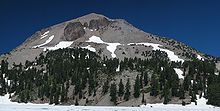 Lassen Peak as seen from Lake Helen
Lassen Peak as seen from Lake Helen
Pyroclastic eruptions then started to pile tephra into cones in the northern area of the park.
Mount Tehama (also known as Brokeoff Volcano) rose as a stratovolcano in the southwestern corner of the park during the Pleistocene. It was made of roughly alternating layers of andesitic lavas and tephra (volcanic ash, breccia, and pumice) with increasing amounts of tephra with elevation. At its height, Tehama was probably about 11,000 feet (3,400 m) high.
Approximately 350,000 years ago its cone collapsed into itself and formed a two-mile (3.2 km) wide caldera after it emptied its throat and partially did the same to its magma chamber in a series of eruptions. One of these eruptions occurred where Lassen Peak now stands, and consisted of fluid, black, glassy dacite, which formed a layer 1,500 feet (460 m) thick (outcroppings of which can be seen as columnar rock at Lassen's base).
During glacial periods (ice ages) of the present Wisconsinan glaciation, glaciers have modified and helped to erode the older volcanoes in the park, including the remains of Tehama. Many of these glacial features, deposits and scars, however, have been covered up by tephra and avalanches, or were destroyed by eruptions.
Roughly 27,000 years ago (older data gave an age of 18,000 years), Lassen Peak started to form as a dacite lava dome quickly pushed its way through Tehama's destroyed north-eastern flank. As the lava dome pushed its way up, it shattered overlaying rock, which formed a blanket of talus around the emerging volcano. Lassen rose and reached its present height in a relatively short time, probably in as little as a few years. Lassen Peak has also been partially eroded by Ice Age glaciers, at least one of which extended as much as 7 miles (11 km) from the volcano itself.
Since then, smaller dacite domes formed around Lassen. The largest of these, Chaos Crags, is just north of Lassen Peak. Phreatic (steam explosion) eruptions, dacite and andesite lava flows and cinder cone formation have persisted into modern times.

Bumpass Hell contains boiling springs, mudpots, and fumaroles There are active geyser hot springs active in the Lassen area. Some of these springs are the site of occurrence of certain extremophile micro-organisms, that are capable of surviving in extremely hot environments.[15]
See also
- Lassen Peak
- Chaos Crags
- Geothermal areas in Lassen Volcanic National Park
- National Register of Historic Places listings in Lassen Volcanic National Park
- List of nationally protected areas of the United States
- Volcanic Legacy Scenic Byway
Footnotes
- ^ "Listing of acreage as of 12/31/2010". Public Use Statistic Office, National Park Service. http://www.nature.nps.gov/stats/Acreage/acrebypark10cy.pdf. Retrieved 2011-05-22.
- ^ "Five Year Annual Recreation Visits Report". Public Use Statistic Office, National Park Service. http://www.nature.nps.gov/stats/viewReport.cfm?selectedReport=SystemComparisonReport.cfm. Retrieved 2011-05-22.
- ^ a b c d e Geology of National Parks, pp. 542-46.
- ^ Geology of U.S. Parklands, p. 154.
- ^ NPS 2003 General Management Plan, Wilderness Zone. Retrieved 4 Sept., 2009.
- ^ USGS: Volcano Hazards of the Lassen Volcanic National Park Area, California
- ^ National Park Service Public Use Statistics Office. Retrieved 3 October 2009.
- ^ Public Use Reporting and Counting Instructions. Retrieved 3 October 2009.
- ^ a b "Geology Fieldnotes for Lassen Volcanic National Park California". http://www.nature.nps.gov/geology/parks/lavo/index.cfm. Retrieved 2010-09-06.
- ^ "Glaciers Online". Archived from the original on 2007-03-05. http://web.archive.org/web/20070305051502/http://glaciers.pdx.edu/gdb/maps/california.php.
- ^ Skimountaineer.com: Cascade Snow
- ^ Franklin, Jerry, F; Fites-Kaufmann, Jo Ann (1996). "21". Status of the Sierra Nevada (III: Biological and Physical Elements of the Sierra Nevada ed.). Sierra Nevada Ecosystem Project. Final Report to Congress. pp. 627–671. http://ceres.ca.gov/snep/pubs/v2s3.html.
- ^ Bolsinger, Charles L.; Waddell, Karen L. (1993). Area of old-growth forests in California, Oregon, and Washington. United States Forest Service, Pacific Northwest Research Station. Resource Bulletin PNW-RB-197. http://www.fs.fed.us/pnw/pubs/pnw_rb197.pdf.
- ^ a b c "Plants". United States National Park Service: Lassen Volcanic National Park. http://www.nps.gov/lavo/naturescience/plants.htm. Retrieved January 13, 2009.
- ^ C.Michael Hogan. 2010. Extremophile. eds. E.Monosson and C.Cleveland. Encyclopedia of Earth. National Council for Science and the Environment, Washington DC
References
 This article incorporates public domain material from websites or documents of the National Park Service.
This article incorporates public domain material from websites or documents of the National Park Service.- Harris, Ann G.; Esther Tuttle, Sherwood D., Tuttle (2004). Geology of National Parks (6th ed.). Iowa: Kendall/Hunt Publishing. ISBN 0-7872-9971-5. http://books.google.com/?id=Xr7v7GNmHs0C&printsec=frontcover#v=onepage&q&f=false.
- Volcano Hazards of the Lassen Volcanic National Park Area, California, U.S. Geological Survey Fact Sheet 022-00, Online version 1.0 (adapted public domain text; accessed 25 September 2006)
External links
- "Lassen Volcanic National Park". National Park Service. http://www.nps.gov/lavo/. Retrieved 2011-05-21.
- "Volcano Hazards of the Lassen Volcanic National Park Area". U.S. Geological Survey. http://pubs.usgs.gov/fs/2000/fs022-00/. Retrieved 2011-05-21.
- "USGS: Geology of Lassen Volcanic National Park". U.S. Geological Survey. http://geomaps.wr.usgs.gov/parks/lassen/index.html. Retrieved 2011-05-21.
- "Historic images of Lassen National Park". University of California. http://www.calisphere.universityofcalifornia.edu/browse/azBrowse/Parks,+Lassen+Volcanic+National+Park. Retrieved 2011-05-21.
National parks of the United States Acadia • American Samoa • Arches • Badlands • Big Bend • Biscayne • Black Canyon of the Gunnison • Bryce Canyon • Canyonlands • Capitol Reef • Carlsbad Caverns • Channel Islands • Congaree • Crater Lake • Cuyahoga Valley • Death Valley • Denali • Dry Tortugas • Everglades • Gates of the Arctic • Glacier • Glacier Bay • Grand Canyon • Grand Teton • Great Basin • Great Sand Dunes • Great Smoky Mountains • Guadalupe Mountains • Haleakalā • Hawaiʻi Volcanoes • Hot Springs • Isle Royale • Joshua Tree • Katmai • Kenai Fjords • Kings Canyon • Kobuk Valley • Lake Clark • Lassen Volcanic • Mammoth Cave • Mesa Verde • Mount Rainier • North Cascades • Olympic • Petrified Forest • Redwood • Rocky Mountain • Saguaro • Sequoia • Shenandoah • Theodore Roosevelt • Virgin Islands • Voyageurs • Wind Cave • Wrangell-St. Elias • Yellowstone • Yosemite • ZionProtected areas of California National Park System National Parks Channel Islands · Death Valley · Joshua Tree · Kings Canyon · Lassen Volcanic · Redwood · Sequoia · YosemiteNational Preserves National Monuments Cabrillo · Devils Postpile · Lava Beds · Muir Woods · Pinnacles · World War II Valor in the Pacific National MonumentNational Seashores National Historical Parks National Historic Sites National Memorials Port Chicago Naval MagazineNational Recreation Areas National Forests National Forests Angeles · Cleveland · Eldorado · Inyo · Klamath · Lassen · Los Padres · Mendocino · Modoc · Plumas · San Bernardino · Sequoia · Shasta-Trinity · Sierra · Six Rivers · Stanislaus · TahoeNational Wilderness
Preservation SystemAgua Tibia · Ansel Adams · Bucks Lake · Caribou · Carson-Iceberg · Castle Crags · Cucamonga · Desolation · Dick Smith · Dinkey Lakes · Emigrant · Golden Trout · Hoover · Inyo Mountains · Ishi · Jennie Lakes · John Muir · Kaiser · Marble Mountain · Mokelumne · Mount Shasta Wilderness · North Fork · San Gabriel · Sanhedrin · San Jacinto · San Rafael · Sespe · Siskiyou · Snow Mountain · South Fork Eel River · South Sierra · South Warner · Thousand Lakes · Trinity Alps · Ventana · Yolla Bolly-Middle Eel · YukiOther State Forests Boggs Mountain Demonstration · Ellen Pickett · Jackson Demonstration · Las Posadas · LaTour Demonstration · Mount Zion · Mountain Home Demonstration · Soquel Demonstration
National Wildlife Refuges Antioch Dunes · Bitter Creek · Blue Ridge · Butte Sink · Castle Rock · Clear Lake · Coachella Valley · Colusa · Delevan · Don Edwards San Francisco Bay · Ellicott Slough · Farallon · Guadalupe-Nipomo Dunes · Hopper Mountain · Humboldt Bay · Kern · Lower Klamath · Marin Islands · Merced · Modoc · Pixley · Sacramento · Sacramento River · Salinas River · San Diego Bay · San Diego · San Joaquin River · San Luis · San Pablo Bay · Seal Beach · Sonny Bono Salton Sea · Stone Lakes · Sutter · Tijuana Slough · Tule LakeState Wildlife Areas Wildlife Areas Antelope Valley · Ash Creek · Bass Hill · Battle Creek · Big Lagoon · Big Sandy · Biscar · Butte Valley · Buttermilk Country · Cache Creek · Camp Cady · Cantara/Ney Springs · Cedar Roughs · Cinder Flats · Collins Eddy · Colusa Bypass · Coon Hollow · Cottonwood Creek · Crescent City Marsh · Crocker Meadows · Daugherty Hill · Decker Island · Doyle · Dutch Flat · Eastlker River · Eel River · Elk Creek Wetlands · Elk River · Fay Slough · Feather River · Fitzhugh Creek · Fremont Weir · Grass Lake · Gray Lodge · Green Creek · Grizzly Island · Hallelujah Junction · Heenan Lake · Hill Slough · Hollenbeck Canyon · Honey Lake · Hope Valley · Horseshoe Ranch · Imperial · Indian Valley · Kelso Peak and Old Dad Mountains · Kinsman Flat · Knoxville · Laguna · Lake Berryessa · Lake Earl · Lake Sonoma · Little Panoche Reservoir · Los Banos · Lower Sherman Island · Mad River Slough · Marble Mountains · Mendota · Merrill's Landing · Miner Slough · Monache Meadows · Morro Bay · Moss Landing · Mouth of Cottonwood Creek · Napa-Sonoma Marshes · North Grasslands · O'Neill Forebay · Oroville · Petaluma Marsh · Pickel Meadow · Pine Creek · Point Edith · Putah Creek · Rector Reservoir · Red Lake · Rhode Island · Sacramento River · San Felipe Valley · San Jacinto · San Luis Obispo · San Luis Reservoir · San Pablo Bay · Santa Rosa · Shasta Valley · Silver Creek · Slinkard/Little Antelope · Smithneck Creek · South Fork · Spenceville · Surprise Valley · Sutter Bypass · Tehama · Truckee River · Upper Butte Basin · Volta · Warner Valley · Waukell Creek · West Hilmar · Westlker River · White Slough · Willow Creek · Yolo BypassEcological Reserves Albany Mudflats · Alkali Sink · Allensworth · Atascadero Creek Marsh · Bair Island · Baldwin Lake · Batiquitos Lagoon · Blue Sky · Boden Canyon · Boggs Lake · Bolsa Chica · Bonny Doon · Buena Vista Lagoon · Butler Slough · Butte Creek Canyon · Butte Creek House · Buttonwillow · By Day Creek · Calhoun Cut · Canebrake · Carlsbad Highlands · Carmel Bay · Carrizo Canyon · Carrizo Plains · China Point · Clover Creek · Coachella Valley · Coal Canyon · Corte Madera Marsh · Crestridge · Dairy Mart Ponds · Dales Lake · Del Mar Landing · Eden Landing · Elkhorn Slough · Estelle Mountain · Fall River Mills · Fish Slough · Fremont Valley · Goleta Slough · Indian Joe Spring · Kaweah · Kerman · King Clone · Laguna Laurel · Loch Lomond Vernal Pool · Lokern · Magnesia Spring · Marin Islands · Mattole River · McGinty Mountain · Morro Dunes · Morro Rock · Napa River · North Table Mountain · Oasis Spring · Panoche Hills · Peytonia Slough · Pine Hill · Piute Creek · Pleasant Valley · Point Lobos · Rancho Jamul · Redwood Shores · River Springs Lakes · Saline Valley · San Dieguito Lagoon · San Elijo Lagoon · San Felipe Creek · San Joaquin River · Santa Rosa Plateau · Springville · Stone Corral · Sycamore Canyon · Sycuan Peak · Thomes Creek · Tomales Bay · Upper Newport Bay · Watsonville Slough · West Mojave Desert · Woodbridge · YaudanchiMarine Protected Areas Abalone Cove · Agua Hedionda Lagoon · Albany Mudflats · Anacapa · Anacapa · Año Nuevo · Asilomar · Atascadero Beach · Bair Island · Batiquitos Lagoon · Big Creek · Big Creek · Big Sycamore Canyon · Bodega · Bolsa Chica · Buena Vista Lagoon · Cambria · Cardiff and San Elijo · Carmel Bay · Carmel Pinnacles · Carrington Point · Catalina Marine Science Center · Corte Madera Marsh · Crystal Cove · Dana Point · Del Mar Landing · Doheny · Doheny · Duxbury Reef · Edward F. Ricketts · Elkhorn Slough · Elkhorn Slough · Encinitas · Estero de Limantour · Fagan Marsh · Farallon Islands · Farnsworth Bank · Fort Ross · Gerstle Cove · Goleta Slough · Greyhound Rock · Gull Island · Harris Point · Heisler Park · Hopkins · Irvine Coast · James V. Fitzgerald · Judith Rock · Julia Pfeiffer Burns · La Jolla · Laguna Beach · Lovers Cove (Catalina Island) · Lovers Point · MacKerricher · Manchester and Arena Rock · Marin Islands · Mia J. Tegner · Moro Cojo Slough · Morro Bay · Morro Bay · Morro Beach · Natural Bridges · Niguel · Pacific Grove Marine Gardens · Painted Cave · Peytonia Slough · Piedras Blancas · Piedras Blancas · Pismo · Pismo-Oceano Beach · Point Buchon · Point Buchon · Point Cabrillo · Point Fermin · Point Lobos · Point Reyes Headlands · Point Sur · Point Sur · Portuguese Ledge · Punta Gorda · Redwood Shores · Refugio · Richardson Rock · Robert E. Badham · Robert W. Crown · Russian Gulch · Russian River · Salt Point · San Diego-Scripps · San Dieguito Lagoon · San Elijo Lagoon · Santa Barbara Island · Scorpion · Skunk Point · Sonoma Coast · Soquel Canyon · South Laguna Beach · South Point · Tomales Bay · Upper Newport Bay · Van Damme · Vandenberg · White Rock (Cambria)National Landscape Conservation System National Monuments National Conservation Areas California Desert · King RangeWilderness Areas Argus Range · Big Maria Mountains · Bigelow Cholla Garden · Bighorn Mountain · Black Mountain · Bright Star · Bristol Mountains · Cadiz Dunes · Carrizo Gorge · Chemehuevi Mountains · Chimney Peak · Chuckwalla Mountains · Chumash · Cleghorn Lakes · Clipper Mountain · Coso Range · Coyote Mountains · Darwin Falls · Dead Mountains · Dick Smith · El Paso Mountains · Fish Creek Mountains · Funeral Mountains · Golden Valley · Grass Valley · Headwaters Forest Reserve · Hollow Hills · Ibex · Indian Pass · Inyo Mountains · Jacumba · Kelso Dunes · Kiavah · Kingston Range · Little Chuckwalla Mountains · Little Picacho · Machesna Mountain · Matilija · Malpais Mesa · Manly Peak · Mecca Hills · Mesquite · Newberry Mountains · Nopah Range · North Algodones Dunes · North Mesquite Mountains · Old Woman Mountains · Orocopia Mountains · Otay Mountain · Owens Peak · Pahrump Valley · Palen/McCoy · Palo Verde Mountains · Picacho Peak · Piper Mountain · Piute Mountains · Red Buttes · Resting Spring Range · Rice Valley · Riverside Mountains · Rodman Mountains · Sacatar Trail · Saddle Peak Hills · San Gorgonio · Santa Lucia · Santa Rosa · Sawtooth Mountains · Sespe · Sheephole Valley · South Nopah Range · Stateline · Stepladder Mountains · Surprise Canyon · Sylvania Mountains · Trilobite · Turtle Mountains · Whipple Mountains ·National Marine Sanctuaries National Estuarine Research Reserves Elkhorn Slough · San Francisco Bay · Tijuana River Estuary
University of California Natural Reserve System Año Nuevo Island · Bodega Marine · Box Springs · Boyd Deep Canyon Desert Research Center · Burns Piñon Ridge · Carpinteria Salt Marsh · Chickering American River · Coal Oil Point · Dawson Los Monos Canyon · Eagle Lake Field Station · Elliott Chaparral · Emerson Oaks · Fort Ord · Hastings · James San Jacinto Mountains · Jenny Pygmy Forest · Jepson Prairie · Kendall-Frost Mission Bay Marsh · Kenneth S. Norris Rancho Marino · Landels-Hill Big Creek · McLaughlin · Motte Rimrock · Quail Ridge · Sagehen Creek Field Station · San Joaquin Freshwater Marsh · Santa Cruz Island · Scripps Coastal · Sedgwick · Stebbins Cold Canyon · Steele Burnand Anza-Borrego · Stunt Ranch Santa Monica Mountains · Sweeney Granite Mountains Desert Research Center · Valentine Eastern Sierra · Younger LagoonHeritage registers: World Heritage Sites · World Network of Biosphere Reserves · National Register of Historic Places · National Historic Landmarks · National Natural Landmarks · California Historical Landmarks · California Points of Historical Interest · California Register of Historical Resources
Categories:- IUCN Category II
- Lassen Volcanic National Park
- National parks in California
- Volcanoes of California
- Parks in Lassen County, California
- Parks in Plumas County, California
- Parks in Shasta County, California
- Parks in Tehama County, California
- Hot springs of California
- Protected areas established in 1916
Wikimedia Foundation. 2010.


